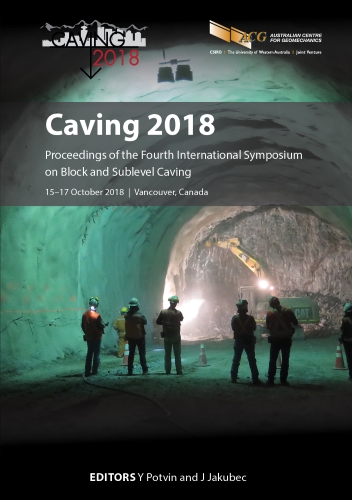Underground mining at Ekati and Diavik diamond mines

|
Authors: Jakubec, J; Lagace, D; Boggis, B; Clark, LM; Lewis, PA |
DOI https://doi.org/10.36487/ACG_rep/1815_03_Jakubec
Cite As:
Jakubec, J, Lagace, D, Boggis, B, Clark, LM & Lewis, PA 2018, 'Underground mining at Ekati and Diavik diamond mines', in Y Potvin & J Jakubec (eds), Caving 2018: Proceedings of the Fourth International Symposium on Block and Sublevel Caving, Australian Centre for Geomechanics, Perth, pp. 73-88, https://doi.org/10.36487/ACG_rep/1815_03_Jakubec
Abstract:
Primary diamond deposits have been mined on an industrial scale only within the past 150 years, mainly as open pit mines. Although underground mining followed soon after open pits reached technical and/or economic limits, it only gained significant recognition in the past 20 years with the exception of Kimberley Mines. A relatively large number of underground mining methods were tested, implemented, and evolved mainly in South African mines. In the mid-1990s, Alrosa also started the development of the first underground diamond mine in Russia, Internationalnaya. Since then, underground mining has been implemented in several of their mines including Aikhal, Mir, and Udachny. China had also experimented with underground mining at Nhangma 701 Diamond Mine at the end of the nineties, but the largest development of underground diamond mining was experienced in Canada. Today, out of some 50 active diamond mines mining kimberlite or lamproite, approximately 15 are underground and another 15 have underground plans or hold the potential. Ekati Diamond Mine is the first diamond mine to be developed near Lac de Gras in the Northwest Territories of Canada. The Koala North pipe had been developed and mined as an open pit; then later as a mechanised open benching operation to test the underground mining method and to provide access to the lower parts of the Panda and Koala pipes. Both the Panda and Koala pipes were also developed and mined underground once the open pit operations were completed. Koala North, North America’s first underground diamond mining operation, was formally opened in 2002. Three principal underground mining methods: open benching, sublevel caving and incline cave mining were implemented at the Ekati mine. Diavik Diamond Mine started open pit production in 2003. By 2005, underground development had commenced with plans to mine the A154 and A418 pipes using backfill methods. As geotechnical knowledge was gained, the mining methods were re-evaluated and the sublevel retreat (SLR) method was chosen for the A154S and A418 pipes, and blasthole stoping (BHS) with cemented rockfill (CRF) was chosen for the A154N pipe. In 2012, the open pits reached their ultimate depths and Diavik became a fully underground operation. The current mine life is approximately 2025. In 2008, De Beers started underground mining on kimberlite sill at Snap Lake. However, the mine closed in 2015 and it is currently on care and maintenance. The focus of this paper is to document experiences with underground mining of kimberlite pipes at the Ekati and Diavik mines.
Keywords: sublevel caving, sublevel retreat, incline caving, Ekati mine, Diavik mine, diamond mining, underground mining
References:
Guest AR, 1989, ‘The compound ring – an alternative ring configuration to improve mine stability’, Proceedings of the Sangorm Symposium on Rock Slope Stability, Sangorm, Marshalltown, pp. 28–33.
Guest AR, 1996, ‘The compound ring – post implementation’, Proceedings of the SAIMM Colloquium – Massive Mining Methods, The Southern African Institute of Mining and Metallurgy, Johannesburg.
Jakubec J & Long, L 2004, ‘Open benching at Ekati diamond mine – Koala North: case study’, in A Karzulovic & MA Alfaro (eds), Proceedings of MassMin 2004, Instituto de Ingenieros de Chile, Santiago, pp. 433–438.
Jakubec, J, Woodward, R, Boggis, B, Clark, L & Lewis, P 2017, Underground Mining at Ekati and Diavik Diamond Mines, poster presentation at the 11th International Kimberlite Conference, Gaborone, Botswana.
Paucar, M & Mthombeni, C 2004, ‘Incline cave: a technical alternative method to mine kimberlite deposit at depth’, Proceedings of MassMin 2004, Instituto de Ingenieros de Chile, Santiago, pp. 393–396.
Silverton, TR & Smart, LR 1992, ‘The design of compound rings at Finsch mine’, in HW Glen (ed.), Proceedings of MassMin 1992, The South African Institute of Mining and Metallurgy, Johannesburg, pp. 125–135.
© Copyright 2026, Australian Centre for Geomechanics (ACG), The University of Western Australia. All rights reserved.
View copyright/legal information
Please direct any queries or error reports to repository-acg@uwa.edu.au
View copyright/legal information
Please direct any queries or error reports to repository-acg@uwa.edu.au
